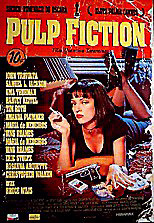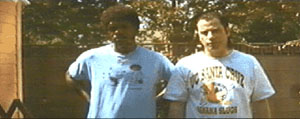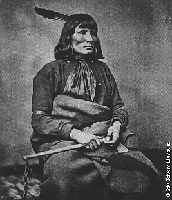This unit on understanding stereotypes in the media will have
three topics:
What,
then, makes something a stereotype (1)?
Here is a definition:
|
...assumptions and beliefs about the
physical, behavioral, and psychological characteristics
assigned to a particular group or class of people...
(Cyrus 65)
|
Examine the images and dialogue from Pulp Fiction
to decide if any stereotypes are used. Answer the discussion
questions.
 |
|

 Listen
to the dialogue. Click on the picture to play the selection
as many times as you wish. Listen
to the dialogue. Click on the picture to play the selection
as many times as you wish. |
| |
| Discussion: Why do you think the people
who designed the poster for Pulp Fiction chose the specific
content they did. Why is the poster formatted as a 10 cent comic
book? What makes the image of the woman a stereotype? What stereotype
is it? How can you tell? |
|
Discussion: In light of the definition
of stereotypes above, what are the physical, behavioral, and
psychological traits associated with "dorks?" Are
those traits linked to any particular group of people? Can any
person of any age, class, race, or gender be labeled a dork?
Why or why not? |
  |
|
Discussion: Have you ever felt you had to laugh
when a stereotype in used in a joke even though you didn't want
to? How does the laughing in the Pulp Fiction dialogue function?
Does laughing make you complicit in the stereotyping that's going
on? What could you do instead of laughing?
 |
Native
Americans have been severely stereotyped in the US. |
| Discussion: Click on the picture to the
left to view the "Ten Little Indians" video and answer
some discussion questions. This link should be used with Ward
Churchill's article "Crimes Against Humanity" in Andersen/
Hill Collins. |

 Contextual analysis
(2): To figure out if something is a stereotype we need to put
it in a context.
Contextual analysis
(2): To figure out if something is a stereotype we need to put
it in a context.
To get a different perspective on Obsession ads go to this website:
 Link
to Adbusters for alternative Obsession ads. http://www.adbusters.org/uncommercials/obsession/index.html
Link
to Adbusters for alternative Obsession ads. http://www.adbusters.org/uncommercials/obsession/index.html
In Philosophical Issues in Prejudice and Discrimination,
we need to cast our analytical nets very wide, out from a family
and individual context to a social, historical and political context.
We need to take a social scientific perspective which, following
C. Wright Mills could be called the "sociological imagination."
|
Mills taught me how to view the world through the lenses
of social theory, and when I took my first look, the world
jumped out at me as if I had donned the 3-D glasses that
Hollywood was hawking at the time. I saw the invisible structures
and secret signals that shape our social lives, that have
a power over us that I thought resided only in face-to-face
relationships. I was astonished at this new vision of life
in which people walked about, not freely, as I had imagined,
but controlled by strings attached to their minds and hearts
by invisible puppeteers.
Parker Palmer in The Courage to Teach,
page 26
|
 |
Exercise 3 at the  bottom
of this unit will help you put issues facing individuals
into a global context. bottom
of this unit will help you put issues facing individuals
into a global context.
The opportunities facing the child in Iraq and the children
in US schools are quite different.
|
|


John Berger uses an intellectual context
to examine the sexual objectification of women in advertising.
He develops a phenomenological approach through a philosophical
analysis of women's consciousness.
 |
A woman has a split self - herself watching
herself being herself - the surveyor and the surveyed. (Berger
46) |
You will see questions about his theory in Exercise
6 at the  bottom of this unit.
bottom of this unit.
Media
literacy (3):
 Media
literacy is the ability to access, analyze, critically
evaluate, and produce communication in a variety of forms.
|
How many forms of media have you encountered so
far today? Brainstorm a list of them now. Bring your
list to class.
Five Principles of Media Literacy:
- Media messages are constructed.
- The media construct reality.
- Different people experience the same media message in different
ways.
- Media are primarily businesses driven by a profit motive.
- Media have embedded values and points of view.
Link to a brief explanation of each of these
principles from the Ontario Ministry of Education.


Questions like the following
are suggested by media literacy experts to analyze any piece of
media:
- Who is "speaking" and what is their purpose? (Who
produced or sponsored the message?)
- Who is the target audience, and how is the message specifically
tailored to them?
- What techniques are used to attract attention?
- What values and lifestyles are promoted? (What is communicated
as good to be, or have, or do? What is not good to be, or
have, or do?)
- What is implied without being specifically stated (especially
about the credibility of the message)?
- What is left out of this message that might be important
to know?
From Project Look Sharp, Ithaca College. Check out their web site,
especially if you want to be a teacher! http://www.ithaca.edu/looksharp


It is important to be clear about the goals
of media literacy. People in the media literacy movement argue that
being genuinely literate in an advanced technological society like
ours requires being able to read and understand all forms of media,
not just the printed word.
Some, like Neil Postman, adopt a "protectionist" approach, seeking
to shield young people from the effects of media addiction and corruption.
But others follow an orientation more like that of Paolo Friere's
literacy work in Brazil. Words, sounds, and images reflect a society's
power relations, and they can be used in oppressive or liberatory
ways.
For Philosophical Issues in Prejudice and Discrimination we will
concentrate on the latter approach to media literacy. We will see
evaluating the media as a way to critically analyze the culture
of our society. We will NOT assume that people, especially young
people, are mindless couch potatoes absorbing values that distort
otherwise healthy American "family" values.
The media are powerful, not because they control our minds and
behavior but because they frame controversies in ways that are assumed
by many to be true.
Study the article "Myth: The Media Tell the Truth about
Youth" from Framing Youth by Mike Males. Placing the
following quotes in the context of his article, explain his
approach to media literacy.
| [There are] two types of media influence progressive critics
have delineated: the media as corrupter of public morals,
and the media as framer of public debate. Of these, the media's
power to frame the debate--in this case, by presenting a systematically
false image of teenagers--is far more powerful and far worse
than its ability to corrupt. After working with children,
adolescents, and their families for a dozen years and studying
patterns of youth and adult behavior, . . . I'm doubtful that
the media corrupt innocent, jello-brained kids. Parents may
not like it that their kids are learning American values,
all the worse that these expose the parents' (unadmitted)
values as well. (263) |
| Media literacy is reasonable, but it doesn't get at the
real problem. What is really required is reevaluation of the
far larger effect on youths of growing up in a product-driven
society whose adults, including parents and teachers, spend
$5 trillion per year on personal consumption. . . The problem
with [some media literacy] analyses. . . is that they encourage
the distancing of adults' from youths' values, blame media
for the latter, and hamper sober examination of adult values.
(274) |
Understanding Stereotypes in the media (USM) unit
assignments:
USM assignment 1:
Study the handout
on stereotypes and summarize what a stereotype is in
your own words. Bring your summary statement into class.
USM assignment 2: Visit the following
website and scan some of the articles:
http://www.uiowa.edu/~commstud/resources/GenderMedia/advertising.html
 Send me an email about what you learned from the articles. Focus
on how women and people of color are portrayed in the media stereotypically.
Send me an email about what you learned from the articles. Focus
on how women and people of color are portrayed in the media stereotypically.
USM assignment 3:
Sexual objectification exercise
USM assignment 4: Political
and economic contexts
USM assignment 5:
Name that context quiz
USM assignment 6:
Cultural definitions of men and women
USM assignment 7:
 |
Click on the picture to the left for a larger
version and to answer some questions.
|
USM assignment 8:
Humorous Quotes
USM assignment 9: Repeat
USM assignment 4 using the 5 principles
and 6 questions above.
 Send
an example to the class archive!
Send
an example to the class archive!

